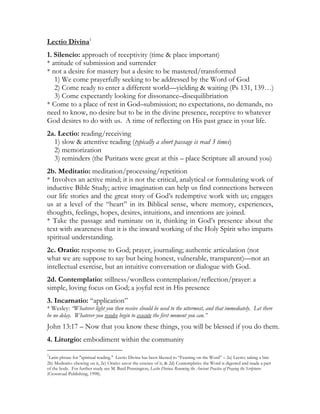Lectio Divina
- 1. Lectio Divina1 1. Silencio: approach of receptivity (time & place important) * attitude of submission and surrender * not a desire for mastery but a desire to be mastered/transformed 1) We come prayerfully seeking to be addressed by the Word of God 2) Come ready to enter a different world—yielding & waiting (Ps 131, 139…) 3) Come expectantly looking for dissonance–disequilibriation * Come to a place of rest in God–submission; no expectations, no demands, no need to know, no desire but to be in the divine presence, receptive to whatever God desires to do with us. A time of reflecting on His past grace in your life. 2a. Lectio: reading/receiving 1) slow & attentive reading (typically a short passage is read 3 times) 2) memorization 3) reminders (the Puritans were great at this – place Scripture all around you) 2b. Meditatio: meditation/processing/repetition * Involves an active mind; it is not the critical, analytical or formulating work of inductive Bible Study; active imagination can help us find connections between our life stories and the great story of God’s redemptive work with us; engages us at a level of the “heart” in its Biblical sense, where memory, experiences, thoughts, feelings, hopes, desires, intuitions, and intentions are joined. * Take the passage and ruminate on it, thinking in God’s presence about the text with awareness that it is the inward working of the Holy Spirit who imparts spiritual understanding. 2c. Oratio: response to God; prayer, journaling; authentic articulation (not what we are suppose to say but being honest, vulnerable, transparent)—not an intellectual exercise, but an intuitive conversation or dialogue with God. 2d. Contemplatio: stillness/wordless contemplation/reflection/prayer: a simple, loving focus on God; a joyful rest in His presence 3. Incarnatio: “application” * Wesley: “Whatever light you then receive should be used to the uttermost, and that immediately. Let there be no delay. Whatever you resolve begin to execute the first moment you can.” John 13:17 – Now that you know these things, you will be blessed if you do them. 4. Liturgio: embodiment within the community 1 Latin phrase for "spiritual reading." Lectio Divina has been likened to “Feasting on the Word” – 2a) Lectio: taking a bite 2b) Meditatio: chewing on it, 2c) Oratio: savor the essence of it, & 2d) Contemplatio: the Word is digested and made a part of the body. For further study see M. Basil Pennington, Lectio Divina: Renewing the Ancient Practice of Praying the Scriptures (Crossroad Publishing, 1998).
- 2. Four Basic Steps given by Richard J. Foster concerning Scripture study 1. Repetition – read the passage over and over again. Read often enough that you actually begin to memorize much of the material without conscious effort to do so. Pray for openness, clarity, and illumination of mind, heart, and spirit. Come to your study with a sense of expectancy. 2. Concentration – pay close attention to detail. Write down everything you observe in the passage. (“Who, what, when, where, why” questions can be helpful here). Create an outline of the passage, with your own titles for the subsections. Look for major themes, key words, literary style, emotional tone. 3. Comprehension – seek understanding of the foundational meaning(s) of the passage. What truths are communicated? What is the author’s primary intent? Synthesize your observations and summarize their significance. 4. Reflection – ask God to reveal what you are to learn from the Scripture, how you are to respond to the insights and discoveries of your study, how they are relevant to your understanding of life, of self, of relationship, of God. Group Lectio Divina  Thoughts to ponder as we come to be transformed by the Holy Spirit: o I wonder what’s on God’s mind right now o What is going on in me right now  Guidelines for group Lectio Divina o Time of quiet preparation o Contemplatio: rest in God, reflect on His presence and character  Share how you have seen His grace in your life o Lectio: slow reading o 1st reading of passage: read aloud…listen for a segment or word that strikes you and is meaningful to you  Silence: 5min…prayerfully repeat this word or phrase  Share your word or phrase with the class o 2nd reading…  Silence: 5min…”Where does the content of this reading touch my life today?” (draw in other questions that respond to the text)  Share aloud briefly…”I hear/I see…” o 3rd reading…  Silence: 5min…”I believe God wants me to…today/this week.”  Sharing aloud (Incarnatio) o Oratio: respond to God and pray for one another… The Power of Scripture in Spiritual Formation2 INFORMATIONAL READING FORMATIONAL READING Seeks to cover as much as possible Focuses on small portions A linear process An in-depth process Seeks to master the text Allows the text to master us The text as an object to use The text as a subject that shapes us Analytical, critical, and judgmental Humble, submissive, willing, loving approach approach Problem-solving mentality Openness to mystery 2See M. Robert Mulholland, Jr., Shaped By The Word (Upper Room Books: Nashville, TN, 1985, revised 2000), 49-63.


